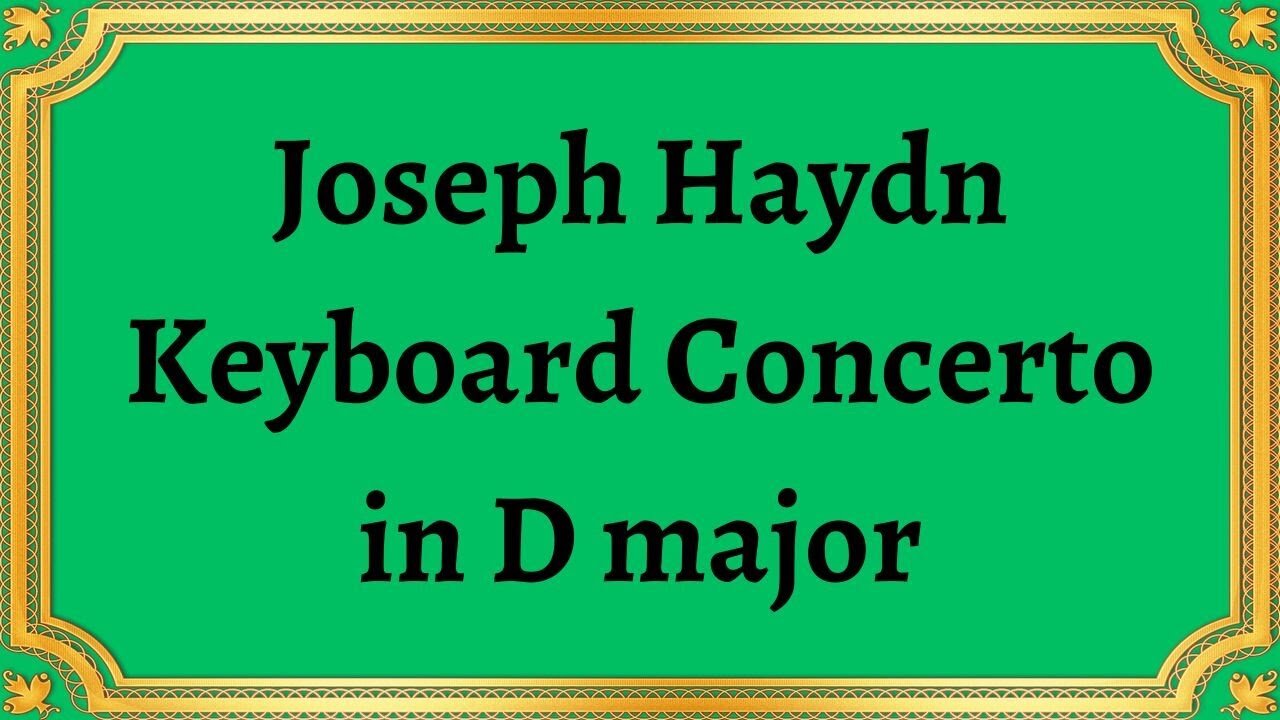Premium Only Content

Joseph Haydn Keyboard Concerto in D major
#Haydn #KeyboardConcertoInDMajor #ClassicalMusic #OrchestralMusic #MusicComposition #Mozart #Symphony #Orchestra #ChamberOrchestra #Vienna #Keyboard #Vivace #UnPocoAdagio #Allegro #Baroque #ClassicalPeriod #MusicAppreciation #MusicEducation #MusicHistory #musictheory
Joseph Haydn was a prolific composer of the classical period, known for his innovative contributions to the development of classical music. One of his most celebrated works is the Keyboard Concerto in D Major, which remains a masterpiece of the genre and continues to delight classical music aficionados worldwide.
Composed in 1780, the Keyboard Concerto in D Major is a seminal work that epitomizes Haydn’s impeccable compositional skill. This concerto consists of three movements, including Vivace, Un Poco Adagio, and Allegro. The first movement is marked by its lively and brisk tempo, forming a perfect opening statement that segues into the rest of the work. The second movement is a slow and thoughtful movement, providing a change in mood from the fast-paced and upbeat first one. Finally, the third movement ends the piece with a dazzling and virtuosic flourish.
The Keyboard Concerto in D Major is one of the most technically challenging pieces of music written by Haydn. It features a dynamic and nuanced interplay between the keyboard and orchestra, showcasing Haydn's unparalleled ability to create a harmonic whole out of disparate and complex musical elements.
The first movement, Vivace, is a playful and buoyant movement dominated by the keyboard's unbridled melody and flourishes, highlighting Haydn's exceptional skills as a composer and pianist. The balance between the orchestra and the keyboard remains a remarkable achievement, as they pass along melodies seamlessly.
The second movement, Un Poco Adagio, is a slow and meditative movement that showcases Haydn's gift for creating moments of tenderness and profound emotion. The keyboard solo is hauntingly beautiful, sustained by the orchestra's gentle accompaniment which creates a sense of calmness and tranquility.
The third movement, Allegro, is a dazzling finale that highlights the keyboardist's technical mastery and virtuosity. It is characterized by its demanding technical passages and rapid keyboard flourishes, underscored by the orchestra's relentless and energetic accompaniment. The movement ends to grand applause after a brilliant cadenza.
In conclusion, Joseph Haydn's Keyboard Concerto in D Major is one of the most technically demanding and brilliant works of the classical period. It ranks among his masterpieces, showcasing his skills as a composer, pianist, and innovator. The interplay between the keyboard and the orchestra is dynamic and nuanced, resulting in a harmonic whole that integrates complexity with fluidity. As a result, the Keyboard Concerto in D Major continues to captivate classical music listeners and performers
You have the opportunity to support the channel https://destream.net/live/RadSiarAl/donate
-
 20:26
20:26
Classical music_Music Inspiration
1 month agoJohann Sebastian Bach Orchestral Suite No. 2 in B minor, BWV 1066
782 -
 2:11:56
2:11:56
megimu32
6 hours agoOTS: With Great Power: Every Spider-Man Movie Unmasked w/ @thisistheraygaming
33.2K4 -
 2:38:48
2:38:48
WickedVirtue
5 hours agoSailing w/ The Crew
35.7K1 -
 4:29:37
4:29:37
Meisters of Madness
8 hours agoThe Finals with Redd
39.7K1 -
 1:27:11
1:27:11
Omar Elattar
13 hours agoThe Dating Expert: "I've Helped 4,000 Men Find LOVE!" - The #1 Alpha Trait Women Secretly Crave!
56K1 -
 LIVE
LIVE
VOPUSARADIO
13 hours agoPOLITI-SHOCK! "END THE FED, END THE LIES & END THE DEEP STATE ONCE AND FOR ALL"!
248 watching -
 1:43:38
1:43:38
LumpyPotatoX2
8 hours agoRumble Creator Round-Table - Let's Talk About It
36.7K2 -
 32:38
32:38
The Mel K Show
11 hours agoMel K & Dr. James Thorp, MD | Sacrifice: The Targeting of the Most Vulnerable | 7-24-25
39.2K14 -
 1:12:41
1:12:41
Donald Trump Jr.
10 hours agoFrom Crypto to AI, There's a New American Energy Revival, Interviews with Asher Genoot & Sen McCormick | TRIGGERED Ep.261
167K61 -
 52:11
52:11
ZeeeMedia
13 hours ago"Meaningful Deep State Prosecution" ft. Robert Barnes | Daily Pulse Ep. 73
46.2K13